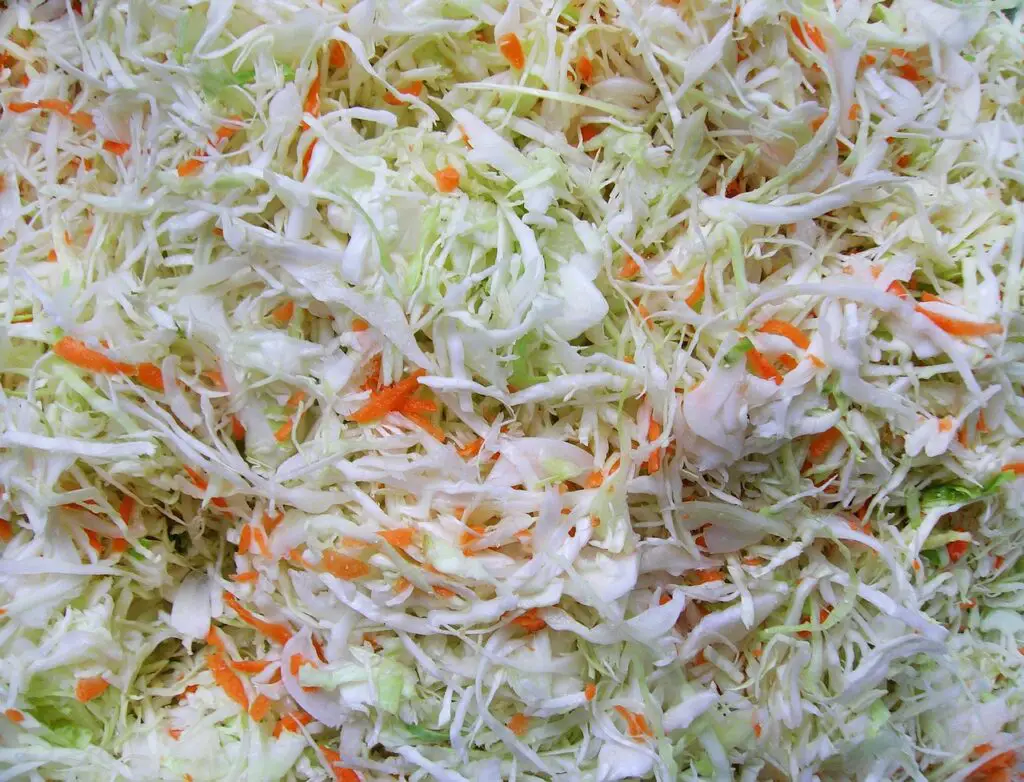
Sauerkraut is a popular fermented food that has been enjoyed for centuries. Made from shredded cabbage, sauerkraut has a tangy and slightly sour flavor that pairs well with a variety of dishes. However, like all fermented foods, sauerkraut can go bad if not stored or prepared properly. In this article, we will explore how to tell if sauerkraut is bad and what to do if you suspect your sauerkraut has gone bad.
One of the most obvious signs that sauerkraut is bad is the presence of mold. Mold can grow on sauerkraut if it is not stored in a cool, dry place or if it is not properly sealed. Mold can be dangerous to consume, so it is important to discard any sauerkraut that has mold on it. Another sign that sauerkraut is bad is a foul odor. If your sauerkraut smells bad or has a strong odor, it may have gone bad and should be thrown away.
In addition to mold and odor, there are other signs that your sauerkraut may have gone bad. These include a slimy or mushy texture, a change in color, or a sour or bitter taste. If you notice any of these signs, it is best to err on the side of caution and discard the sauerkraut. By following these guidelines, you can ensure that your sauerkraut stays fresh and safe to eat.
Table of Contents
Understanding Sauerkraut

Sauerkraut is a type of fermented food that is made from cabbage. It is a popular food in many cultures and is known for its tangy flavor and health benefits.
Fermentation is the process of converting carbohydrates into alcohol or acid using microorganisms such as bacteria or yeast. In the case of sauerkraut, the fermentation process involves lactic acid bacteria that break down the sugars in the cabbage, producing lactic acid.
Fermented foods, including sauerkraut, are known for their probiotic content. Probiotics are live microorganisms that provide health benefits when consumed in adequate amounts. They are believed to improve digestive health, boost the immune system, and even improve mental health.
Sauerkraut is also a good source of dietary fiber, which is important for maintaining a healthy digestive system. It is low in calories and fat, making it a healthy addition to any diet.
In addition to its health benefits, sauerkraut is a versatile ingredient that can be used in a variety of dishes. It can be eaten on its own as a side dish, added to sandwiches and salads, or used as a topping for hot dogs and sausages.
Overall, sauerkraut is a healthy and flavorful food that can provide a range of health benefits. By understanding the fermentation process and the nutrients it provides, individuals can incorporate sauerkraut into their diet and enjoy its many benefits.
The Fermentation Process

Fermentation is a process that occurs when bacteria and yeast break down sugars in food, producing lactic acid. This process is what gives sauerkraut its unique tangy flavor and texture. The fermentation process can take anywhere from a few days to several weeks, depending on the temperature and other conditions.
During the fermentation process, the bacteria and yeast consume the sugars in the cabbage and produce lactic acid. This acid lowers the pH level of the sauerkraut, making it more acidic. The acidity level is what helps to preserve the sauerkraut and prevent the growth of harmful bacteria.
Salt is an important ingredient in the fermentation process. It helps to create an environment that is conducive to the growth of the beneficial bacteria and yeast, while inhibiting the growth of harmful bacteria. The amount of salt used in the fermentation process can vary, but it is typically around 2% of the weight of the cabbage.
While vinegar can be used to make sauerkraut, it is not necessary. The lactic acid produced during the fermentation process is what gives sauerkraut its characteristic sour flavor. Adding vinegar to the sauerkraut can actually slow down the fermentation process and prevent the growth of beneficial bacteria and yeast.
The acidity level of sauerkraut is an important factor in determining whether it is safe to eat. The pH level of sauerkraut should be below 4.6 to prevent the growth of harmful bacteria. It is important to note that sauerkraut that has gone bad may not necessarily have a high pH level. Other signs of spoilage include a slimy texture, mold growth, and an off smell.
How to Store Sauerkraut

Proper storage of sauerkraut is critical to maintaining its quality and preventing spoilage. Here are some tips on how to store sauerkraut:
- Refrigerate: Sauerkraut should be stored in the refrigerator at all times, even if it is unopened. This will help to slow down the fermentation process and prevent the growth of harmful bacteria.
- Use an Airtight Container: To keep sauerkraut fresh for longer, it is essential to store it in an airtight container. This will help to keep out moisture and air, which can cause the sauerkraut to spoil.
- Store in Glass Jars or Plastic Containers: Sauerkraut can be stored in either glass jars or plastic containers. However, it is important to ensure that the container is food-grade and does not contain any harmful chemicals that could leach into the sauerkraut.
- Keep in a Cool, Dry Place: Sauerkraut should be stored in a cool, dry place away from direct sunlight. A pantry or cupboard is an ideal location for storing sauerkraut.
- Check the Expiration Date: If you have store-bought sauerkraut, be sure to check the expiration date before storing it. If the sauerkraut is past its expiration date, it should be discarded.
By following these simple tips, you can ensure that your sauerkraut stays fresh and delicious for longer.
Shelf Life of Sauerkraut

Sauerkraut is a fermented food made from cabbage. It is a popular condiment that is used in various dishes and is known for its sour and tangy taste. However, like any other food, sauerkraut also has a limited shelf life.
The shelf life of sauerkraut depends on various factors, such as whether it is homemade or store-bought, whether it is pasteurized or unpasteurized, and whether it is refrigerated or not. Here is a breakdown of the shelf life of different types of sauerkraut:
- Homemade sauerkraut: Homemade sauerkraut can last for up to six months if stored properly. It is best to keep it in a glass jar with a tight-fitting lid and store it in a cool, dark place.
- Refrigerated sauerkraut: Refrigerated sauerkraut has a shorter shelf life than homemade sauerkraut. It can last for up to two weeks in the refrigerator. Make sure to keep it in an airtight container to prevent it from drying out.
- Unpasteurized sauerkraut: Unpasteurized sauerkraut is not heated to kill bacteria, which means it has a shorter shelf life than pasteurized sauerkraut. It can last for up to two months in the refrigerator.
- Pasteurized sauerkraut: Pasteurized sauerkraut has a longer shelf life than unpasteurized sauerkraut. It can last for up to six months in the refrigerator.
- Canned sauerkraut: Canned sauerkraut has a longer shelf life than refrigerated sauerkraut. It can last for up to two years if stored properly. Make sure to check the best-by date before consuming it.
It is important to note that the shelf life of sauerkraut can be affected by various factors, such as temperature, humidity, and exposure to air. Always check for signs of spoilage, such as mold, off-odor, or slimy texture, before consuming sauerkraut. If sauerkraut has passed its expiration date, it is best to discard it.
Signs of Spoilage

Sauerkraut is a fermented food made from cabbage that has been sliced and salted. While it can last for a long time in the fridge, it can still spoil if not stored properly or if it has been contaminated. Here are some signs of spoilage to look out for when checking if sauerkraut has gone bad:
Mold
One of the most obvious signs of spoilage is the presence of mold. If you see mold on the surface of the sauerkraut, it is best to throw it away. Mold can cause allergic reactions and other health problems, so it is important to avoid consuming any food that has mold on it.
Odor
If the sauerkraut has an off-smell or a foul odor, it may be a sign that it has gone bad. The smell should be sour, but not overly pungent or unpleasant. If the smell is too strong or unusual, it is best to discard the sauerkraut.
Color
Sauerkraut should have a consistent color throughout. If you notice any discoloration or black spots, it is best to throw it away. These could be signs of mold or other bacteria that can be harmful to your health.
Taste
The taste of sauerkraut should be sour and tangy. If it tastes off or has a strange flavor, it may be a sign that it has gone bad. If the taste is too sour or too salty, it may also be a sign that the sauerkraut has been over-fermented.
Texture
The texture of sauerkraut should be crunchy and firm. If it feels slimy or mushy, it may be a sign that it has gone bad. This could be due to bacterial growth or improper storage.
In summary, it is important to pay attention to the signs of spoilage when checking if sauerkraut has gone bad. Mold, off-smell, discoloration, strange taste, and slimy texture are all indicators that the sauerkraut should be discarded.
Safety Measures and Risks
When it comes to sauerkraut, it is important to take safety measures to ensure that it is not spoiled. Harmful bacteria can grow on sauerkraut, which can cause food poisoning. It is important to be aware of the risks associated with sauerkraut to avoid any potential health issues.
One of the risks associated with sauerkraut is bacterial growth. Sauerkraut is made by fermenting cabbage with salt and water, which creates an environment that is ideal for bacteria to grow. If the sauerkraut is not stored properly, harmful bacteria can grow and cause food poisoning. It is important to store sauerkraut in the refrigerator at all times to prevent bacterial growth.
Another risk associated with sauerkraut is botulism. Botulism is a rare but serious illness that can be caused by a toxin produced by the bacterium Clostridium botulinum. This bacterium can grow on improperly canned or fermented foods, including sauerkraut. Symptoms of botulism include nausea, vomiting, and difficulty breathing. It is important to always check the expiration date of sauerkraut and to discard any sauerkraut that appears to be spoiled.
In addition to the risks associated with sauerkraut, it is important to follow proper food safety practices when handling and preparing it. Always wash your hands before handling sauerkraut and use clean utensils and equipment. If you are serving sauerkraut at a party or event, be sure to keep it at the proper temperature to prevent bacterial growth.
Overall, sauerkraut can be a healthy and delicious addition to your diet, but it is important to take safety measures and be aware of the risks associated with it. By following proper food safety practices and storing sauerkraut properly, you can enjoy this tasty treat without any health issues.
Sauerkraut in the Kitchen
Sauerkraut is a fermented cabbage dish that has been around for centuries. It is a popular side dish, condiment, and ingredient in many recipes. Sauerkraut is also known as pickled cabbage or pickles, and it can be made from red cabbage leaves as well.
When it comes to sauerkraut, it is important to know how to tell if it is bad. Sauerkraut that has gone bad can be dangerous to eat and can cause food poisoning. Here are some signs to look out for:
- Mold: If you see mold on the surface of the sauerkraut, it is a sign that it has gone bad. Mold can be dangerous to eat, so it is best to throw it away.
- Foul Smell: If the sauerkraut smells bad, it is a sign that it has gone bad. Sauerkraut should have a sour smell, but if it smells foul, it is best to throw it away.
- Slimy Texture: If the sauerkraut has a slimy texture, it is a sign that it has gone bad. Sauerkraut should have a crunchy texture, so if it feels slimy, it is best to throw it away.
When storing sauerkraut, it is important to keep it in an airtight container in the refrigerator. This will help to prevent mold and bacteria from growing on it. Sauerkraut can last for several months in the refrigerator if stored properly.
Sauerkraut can also be used as an ingredient in many recipes, such as kimchi. Kimchi is a Korean dish that is made from fermented vegetables, including sauerkraut. Sauerkraut can also be used as a condiment, such as on hot dogs or sandwiches.
In conclusion, sauerkraut is a versatile dish that can be used in many ways. However, it is important to know how to tell if it has gone bad to prevent food poisoning. If you notice any of the signs mentioned above, it is best to throw it away.
Freezing and Thawing Sauerkraut
Freezing sauerkraut is an excellent way to extend its shelf life. It is also a convenient way to store leftover sauerkraut for future use. However, freezing and thawing sauerkraut can affect its texture and flavor. Here are a few things to keep in mind when freezing and thawing sauerkraut:
- Freezing sauerkraut: Sauerkraut can be frozen in an airtight container or a freezer bag. Make sure to remove as much air as possible to prevent freezer burn. Label the container with the date and freeze for up to 8 months.
- Thawing sauerkraut: Thaw sauerkraut in the refrigerator overnight. Do not thaw sauerkraut at room temperature, as this can cause bacterial growth. Once thawed, sauerkraut may be used immediately or refrigerated for up to 1 week.
- Texture and flavor changes: Freezing and thawing can cause sauerkraut to become softer and less crunchy. The flavor may also become slightly milder. However, these changes are usually not significant enough to affect the overall quality of the sauerkraut.
- Opened sauerkraut: If you have opened a can or jar of sauerkraut and do not plan to use it all at once, transfer the remaining sauerkraut to an airtight container and freeze it. This will prevent spoilage and extend its shelf life.
In summary, freezing and thawing sauerkraut is a great way to extend its shelf life and store leftovers. While the texture and flavor may change slightly, these changes are usually not significant enough to affect the overall quality of the sauerkraut. Remember to label and date the container, remove as much air as possible, and thaw sauerkraut in the refrigerator for best results.
Additional Information
When it comes to sauerkraut, there are a few additional pieces of information that can be helpful in determining whether or not it has gone bad. Here are some things to keep in mind:
Can and Round
If the sauerkraut is in a can or a round container, it’s important to check the expiration date. If the sauerkraut is past its expiration date, it’s best to err on the side of caution and assume it has gone bad.
Flavor and Label
If the sauerkraut has an off flavor or odor, or if there are any signs of mold, it’s best to throw it away. Additionally, if the label on the sauerkraut indicates that it has been heat treated, it may not contain live cultures and may not be suitable for making fermented foods.
Sunlight and Yeasty
Sauerkraut should always be stored in a cool, dark place. Exposure to sunlight can cause the sauerkraut to spoil more quickly. Additionally, if the sauerkraut has a yeasty or alcoholic smell, it may have begun to ferment further and may not be safe to eat.
Cloudy Brine and Salty
If the brine in the sauerkraut is cloudy or murky, it may be an indication that the sauerkraut has gone bad. Additionally, if the sauerkraut tastes overly salty, it may have been contaminated with too much salt during the fermentation process.
Vitamin C and Moldy Kraut
Finally, it’s worth noting that sauerkraut is a good source of vitamin C. However, if the sauerkraut has been contaminated with mold, it may have lost some of its nutritional value. If you notice any signs of mold on your sauerkraut, it’s best to discard it.